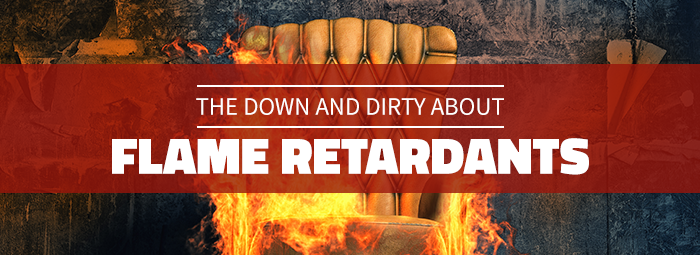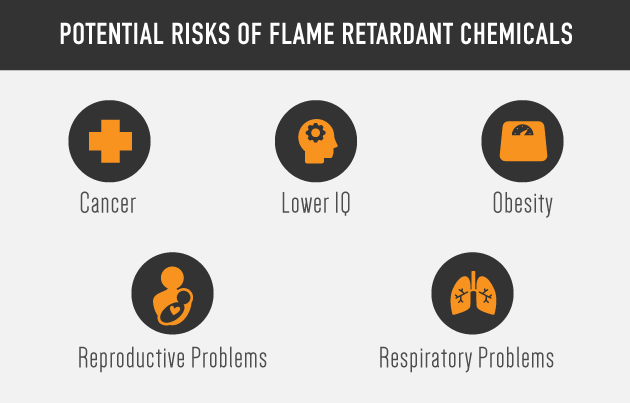
No one wants a fire in their building. If you own or manage a workplace, you follow certain safety standards to protect your employees and property from fire. Yet, in 2013 alone, more than a million fires broke out in the United States. The U.S. Fire Administration, which collects and analyzes fire data, determined that these fires cost $11.5 billion, caused almost 16,000 injuries, and killed more than 3,000 people.
Fires are far too costly to skimp on fire safety protocol. In an effort to protect against fires, our government, manufacturers, and businesses have employed flame-retardant chemicals that attempt to inhibit or drastically reduce the damage of fires. Recent research is showing that these flame retardants may not be the solution or as safe that many think they are.
What are Flame Retardants, Exactly?
Flame retardants are commonly known as an alternative to flammable materials, but what are they? Though you may think of clothing, furnishings, and first aid blankets when you hear “flame retardant”, the term actually refers to a type of chemical that stops or delays the spread of flames. These chemicals are incorporated into textiles, plastics, electronics, and even building insulation. They’re designed to form a protective shield that can withstand a certain amount of heat.
How Did Flame Retardants Get Popular?
Thanks to years of studies and advertising regulations, cigarette smoking is far less common than it was in the 1970’s. However, we still live and work with the flame retardant chemicals that were first used in an effort to stop cigarette fires. Because cigarettes caused so many house fires in the 20th century, California lawmakers asked cigarette manufacturers to devise fire-safe cigarette. Instead of solving the obvious problem, their lobbyists and lawyers set their sights on a different product: furniture.

After the tobacco industry pointed at flammable upholstery materials, California forgot about the cigarettes and began passing laws to increase furniture safety standards. These new standards, which affect the whole country (due California’s furniture shipments), required the use of flame-retardant chemicals in our furniture. But it’s not just furniture where flame retardants are found.
Where Are Flame Retardants Found?
Polyurethane foam is one of the most common synthetic fillings for furniture, but it’s also found in insulation, electronics, toys, nap mats, and other everyday products. Because this foam is flammable, manufacturers add flame retardant chemicals to it to meet government safety standards.
In fact, California actually requires furniture foam to withstand an open flame for 12 or more seconds. This standard has been in place since 1975, but it does not include additional rules to ensure the safety of the chemicals used. Many flame retardant chemicals actually come with a bevy of health and environmental risks.

(How) Do Flame Retardants Work?
Several university researchers explored the benefits and risks of these chemicals in a 2011 report, and they couldn’t find any fire safety benefits that would support the need for mandatory chemical additives. Quite simply, the researchers found that materials that comply with the California law didn’t actually reduce the severity of fires. They don’t prevent ignitions from small open flames, either.
The report stressed the severe environmental hazards posed by some of these flame-retardant chemicals, and asked lawmakers and regulators to consider pollution and health risks posed by supposedly safe additives.
The Safety Risks and Regulations
The health risks of flame retardant use are far too serious to ignore. Flame retardants in upholstery actually appear in dust particles throughout homes and businesses. When people breathe these particles, the chemicals accumulate in their bodies.
Scientific American warns us that some flame retardant chemicals, including polybrominated diphenyl ethers, have been linked to cancer, lower IQs, and reproductive problems. The Environmental Protection Agency has also found links to obesity and respiratory problems.

Decades after these damaging laws were first passed, lawmakers are finally paying attention to the safety warnings. In 2014, California’s flammability standards changed to reflect alternative fireproofing methods. Many materials are actually naturally resistant to fires, so this new state standard allows the use of wool liners and other natural materials that are less likely to spread a fire.
Tom Harrington from CBS News investigated flame retardants in our homes as well and revealed the toxic chemicals used to prevent or slow down the spread of fire may be making us sick, and may not be as effective as you think.
Do Your Research
So, what should you do to protect your family members and employees? Start by doing your research before you buy products with synthetic foam and other products. Avoid filling your buildings with products that have chemical flame retardants. Opt for natural fillings and other natural materials that are less likely to catch on fire in the first place.
It’s clear today that strict flame retardant policies are misguided solutions to our fire fighting and fire prevention problems. By exposing the issues with flame retardant chemicals, facing the reality of the situation, and finding alternatives, we can improve our communities and make our workplaces safer. Do your research!
